By Victoria Wallace and Alyssa Siegel-Miles, UConn Extension
Weed control on school turf areas and athletic fields is frequently a source of frustration and concern for school grounds managers, especially those that are challenged to reduce weed populations using pesticide-free practices. Weed populations disrupt surface uniformity, impact turf density, and pose a footing hazard, which directly impacts player safety. Besides being unattractive and disruptive to the athletic field surface, weeds compete with turfgrasses for light, nutrients, water and space.
2010 legislation in CT banned the application of pesticides, eliminating common weed control practices that had been used by turf managers on the grounds of public and private K-8 grade schools. Since then, weed encroachment has been a persistent concern along fence lines, parking lot curbs and sidewalks, and in wear-stressed infields and playing fields (particularly those fields that are non-irrigated, compacted, and poorly fertilized). Control measures to combat weeds must be predominantly focused on cultural management practices that promote a healthy, dense turf. Removal of problem weeds via mechanical means (e.g., mowing, weed-whacking, hand-rogueing) and the incorporation of EPA exempt “minimum risk” 25(b) products offers limited success in the reduction of weed populations.
The first step to eradicate a problem weed is correct identification. Eradication/reduction of weed populations and a cultural management program can then be structured around the weed lifecycle and its competition with desired turfgrasses.
The purpose of this document is to serve as a resource in the identification of commonly observed weeds in school landscapes. Key ID characteristics are highlighted to simplify identification.
Click on the name of the species below to go directly to the corresponding section.

INDEX OF WEEDS COMMONLY FOUND IN TURF ON SCHOOL PROPERTIES:
GRASSES AND SEDGES:
Annual Bluegrass (Poa annua)
- Cool-season winter annual. (Some types are biennial or perennial.)
- Bunch-type growth habit, prolific seed head production at any height, prefers moist/wet soils. Tolerates close mowing.
- Leaf: Boat-shaped tip of blade, light green in color; wrinkle across leaf blade.
- Stems: folded; long, membranous, white ligule with jagged tip; auricles absent.
- Seedhead: open, greenish-white pyramidal panicle, .75-2.5 in. long. Prolific seedhead production.

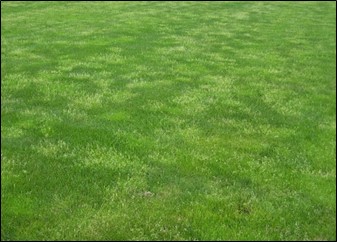
Large Crabgrass (Digitaria sanguinalis)
- Summer annual.
- Grows more quickly than turfgrass in summer. Prefers high fertility soils; tolerates low height of cut.
- Leaves: 2-5 in. long, 4-10 mm wide; sheath and blades hairy (stiff hairs at 90 degrees to plant surface). Collar is broad with long hairs at the margin. 1-2 mm jagged, membranous ligule. Leaves are pointed, flat and rolled in the bud, have a prominent midvein. Seedlings grow upright, then becomes more prostrate to ground as plant matures. Auricles absent.
- Stems: lie prostrate to ground with tips ascending, branches at lower node. Elongated stems root at the nodes and are flattened in cross-section.
- Flower/Inflorescence: develops at the tip of the stem and is composed of 2-6 spikes. Each spike is approximately 4 in. in length and flowers late summer to November.
- Seed: on spikelets, 2.5 mm in length, football-shaped, and have a stalk with a disk-like tip.
- Roots: fibrous and shallow-rooted.
- Reproduction: by seed and plant can root at stems. Seeds germinate mid-spring through late summer.
Note: this species is often confused with smooth crabgrass. Refer to pictures and description for distinction.
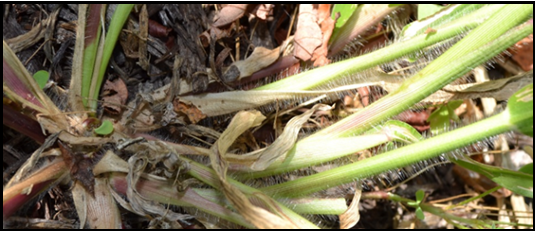
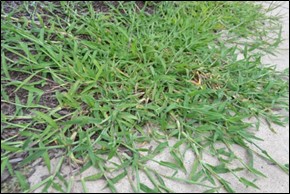

Smooth Crabgrass (Digitaria ischaemum)
- Summer annual. 6-18 in. tall; generally smaller than large crabgrass.
- Leaves: similar to large crabgrass, but sheath and leaf blades have few to no hairs. 1-2 mm membranous ligule. Sheath lacks hairs and is closed, hairs on collar region. Leaf blades up to 4.5 in. long and 8 mm wide. Leaves rolled in bud. Seedlings grow upright and as matures, begins to grow more prostrate to ground. Leaves and sheaths may turn maroon/red color as plant ages.
- Stems: lie prostrate to ground with tips ascending, branches at lower nodes.
- Flower/Inflorescence: seedhead develops at the tip of the stem and is composed of 2-6 branches (spikes). Each spike is approximately 4 in. in length. Spikelets form off each spike, contains short hairs, and bloom from mid-summer into autumn.
- Roots: fibrous and shallow-rooted.
- Reproduction: primarily by seed.

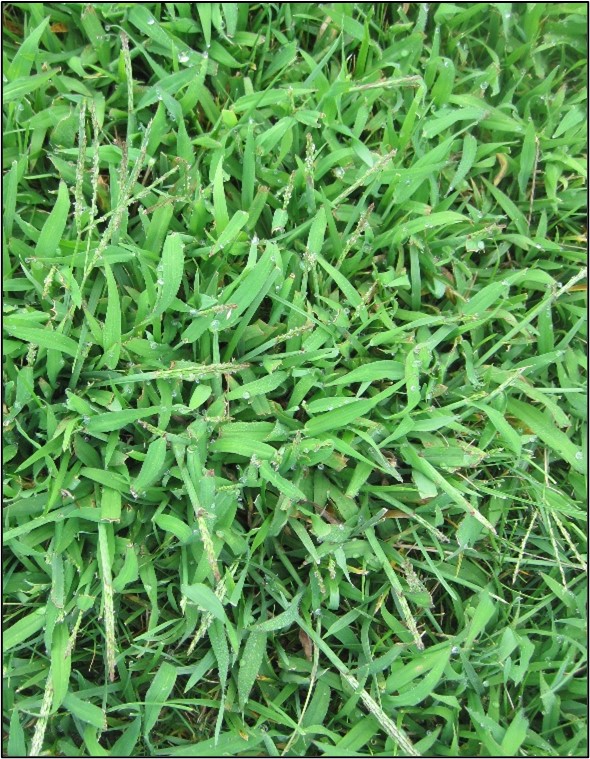
Goosegrass (Eleusine indica)
- Summer annual. Prefers compacted and often poorly drained soils.
- Leaves: 2-8 in. long, 3-6 mm wide. Flattened leaf sheaths in a basal rosette with a white to silvery Leaves are folded in the bud, lack auricles, and have a short, membranous, unevenly toothed ligule that is cleft in the center. Leaf blades are smooth or occasionally sparsely hairy on both surfaces and have rough margins. The collar is broad, white, and sparsely hairy at the edges.
- Stems: prostrate, mat-like rosette with radiating from a central point; can grow erect to 2 ft.
- Flowers: June to September.
- Seedheads: 2-10 spikes in clusters at top of stem. Spikelets are flattened in 2 rows along the spike, resembling a zipper; contain 3-6 reddish brown to black seeds. Seedheads mature in late summer through early autumn.
- Roots: Does not root at nodes.
- Reproduction: by seed. Germinates in early to midsummer when soil temperatures are above 65 degrees F. Usually germinates 2-3 weeks later than crabgrass.
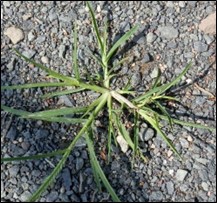
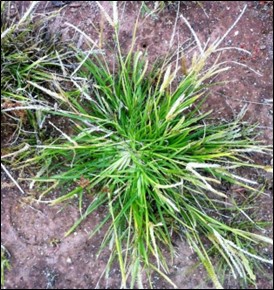
Yellow Nutsedge (Cyperus esculentus)
- Sedge (grass-like perennial).
- Prefers moist or poorly drained soils, but grows in many soil types.
- Leaves: yellow-green leaf blades are narrow, flat, shiny; have parallel veins that form grooves and ridges. Leaves are produced at the base of the plant in groups of 3, forming a sheath around the stem.
- Stems: 3-angled, triangular.
- Flowers: yellow-brown spikelet of terminal clusters, present July to September. Flowering stems are erect, unbranched, triangular in cross section, smooth, yellow-green, solitary.
- Reproduction: primarily by underground rhizomes and nutlets, making it difficult to eradicate new plants. Grows in clumps and spreads aggressively.
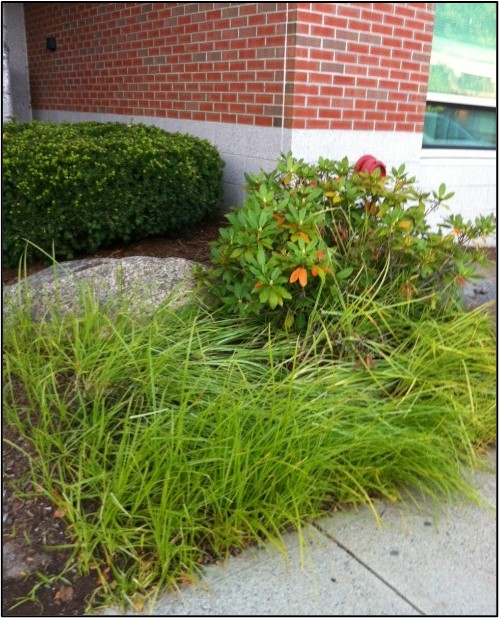
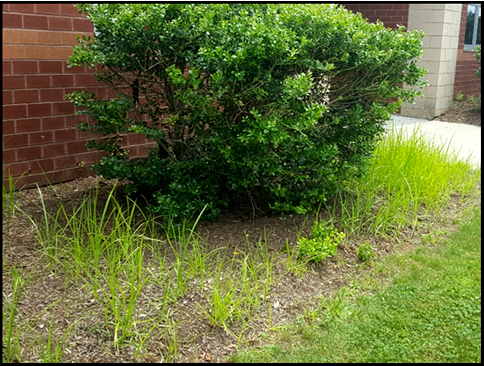

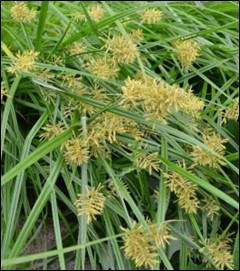
Quackgrass (Elytrigia repens, syn. Elymus repens)
- Perennial.
- Difficult to eradicate due to rhizomes. Prefers fertile, cultivated soils. Tolerates mowing.
- Leaves: 5-12 in. long, up to 2.5 mm wide. Rolled in the bud. Auricles are narrow, slender, and clasp the stem. The ligule is membranous and very short (under 1 mm). Hairy to smooth on the upper surface, smooth on the lower surface. The collar is broad.
- Stems: Claw-like auricles (long and prominent) clasp stem. Sheath (encircles stem) can be hairy or smooth.
- Flowers: in June and July; inflorescence matures mid-summer. Seedhead is a long spike, 2-8 in. long. Fruit spikelets are arranged in 2 rows along the axis.
- Roots: fibrous; arise at the nodes of long, sharp-tipped rhizomes.
- Reproduction: by seed and rhizome.
- Tall fescue and ryegrasses are similar in bunch-type growth habit to quackgrass, but lack elongated rhizomes.
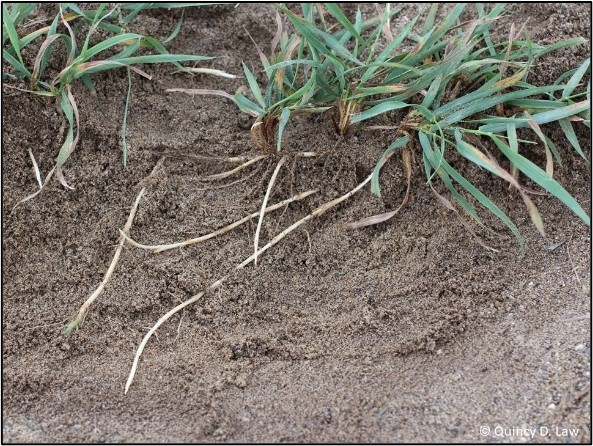
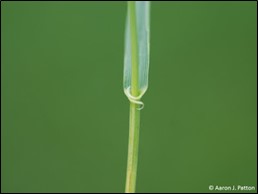
Japanese Stiltgrass (Microstegium vimineum)
- Annual. Sprawling habit; .5-3.5 ft. tall. Shade tolerant and can completely displace native vegetation in forest edges, fields, and trails.
- Leaves: pale-green, alternate, 1-3 in. long, asymmetrical with a shiny, whitish off-center midrib. Leaves are longer than wide, with a pointy tip (lanceolate). Upper and lower leaf surface is slightly hairy. A silvery strip of reflective hairs runs down the center of the upper leaf surface. Throat collar hairy. Ligule membranous with a hairy margin.
- Stems: usually droop; can root at nodes. Ascending to reclining, slender and wiry, up to 4 ft. long. Alternate branching. Covered by overlapping sheaths with hairless nodes and internodes. Green to purple to brown.
- Flowers: late summer, continuing into fall; terminal, thin, and spike-like flower stalks develop in the axils of the leaves or at the top of the stems; to 3 in. long. Unbranched or with one to three lateral branches on an elongated wiry stem. Spikelets are paired; the outer spike is stemmed and the inner spike is sessile.
- Seedheads: produced from late September to early October. Seed stalks partially remain during winter.
- Reproduction: by seed; each plant can produce an estimated 100-1,000 seeds. It also spreads by rooting at nodes along the stem. A new plant emerges from each node.
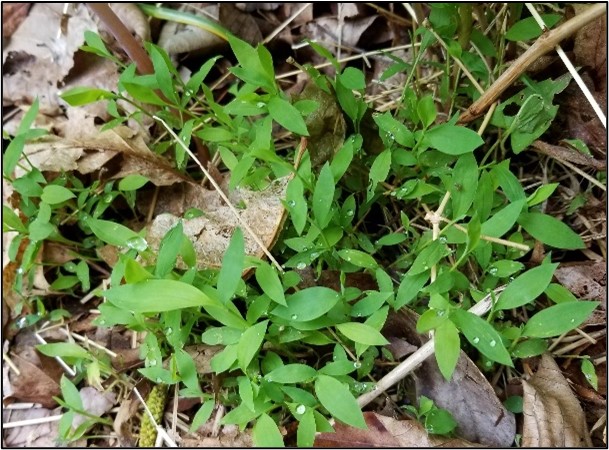
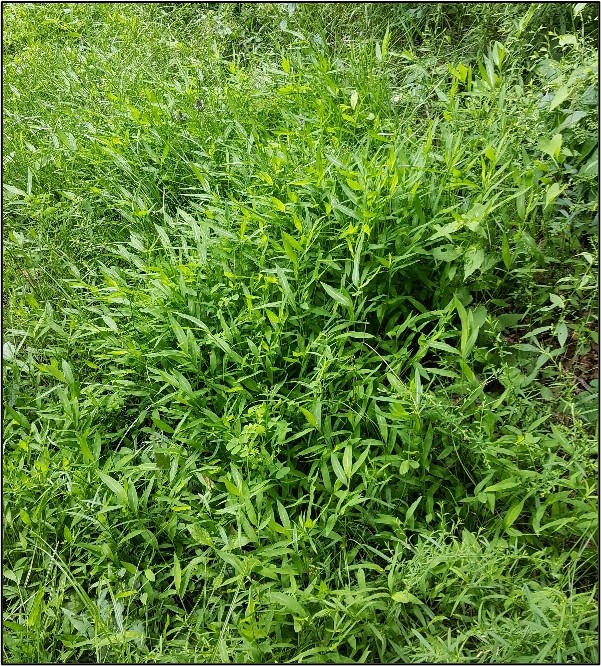
HERBACEOUS PERENNIALS & ANNUALS:
Common Chickweed (Stellaria media)
- Winter annual. Height to 16 in. Prefers shady, moist, fertile soil. Problem in both landscape beds and shady turf areas.
- Leaves: (juvenile) ovate with slender reddish hypocotyl, sparsely hairy.
- Leaves: (mature) opposite on the stem, oval or egg-shaped. Length .5-1 in., light green, smooth (possibly hairy at base and on petioles). Leaves at upper portion of branch are sessile, lower leaves have petioles. Leaves fold up at night and when it’s going to rain.
- Stems: weak, prostrate along the ground; roots at nodes when touching soil. Multiple branches. Slightly swollen at joints. Light green in color with lines of hairs in vertical rows that changes sides with each pair of leaves.
- Flowers: small, 3-6 mm wide, white, (alone or in clusters) at ends of stems. 5 deeply-lobed petals (heart-shaped). Blooms March to August.
- Fruit: oval capsule, whitish in color.
- Roots: shallow and fibrous.
- Reproduction: by seed; germinates in early spring and late summer, sometimes throughout summer. One or two generations can be produced each year.
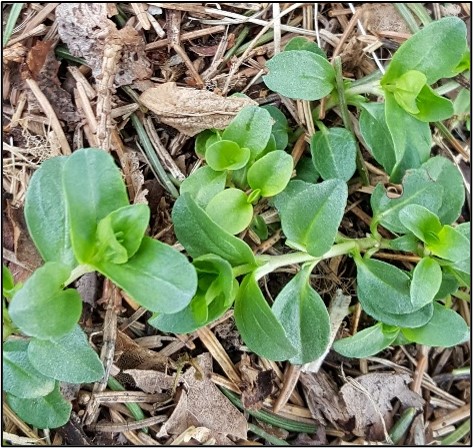
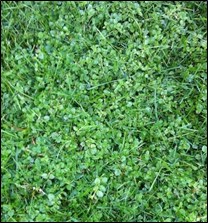

White Clover (Trifolium repens)
- Perennial. Creeping habit, forming mats. Legume (fixes nitrogen); very apparent in soils of poor fertility.
- Prevalent in moist, infertile soils; can be slippery in areas of play, such as athletic fields; tolerates low-mowing height.
- Leaves: (mature) composed of 3 leaflets, alternate, smooth, grayish green on the lower surface, green on upper surface, usually with a white/light green mark near the base of each leaflet.
- Flowers: white, produced throughout summer in rounded heads at the end of long flower stalks that arise from leaf axils. Flowers are a pollen source for bees.
- Roots: fibrous; creeping above ground stems (stolons) root at nodes.
- Reproduction: by seed and stolons.
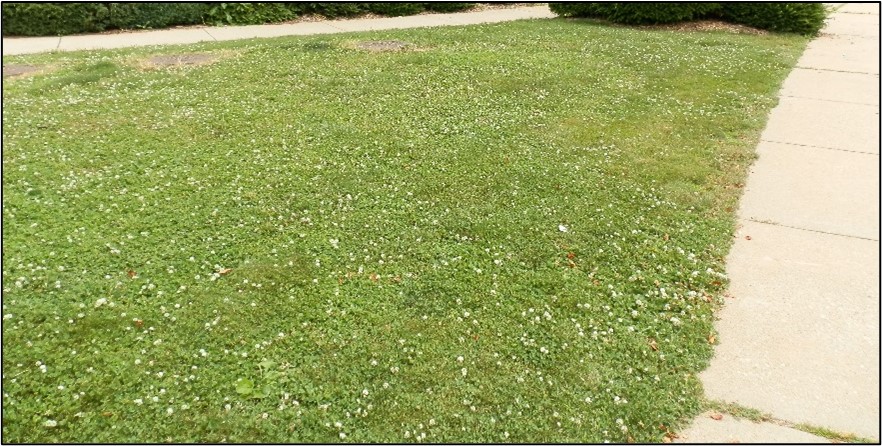
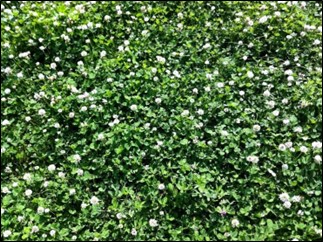
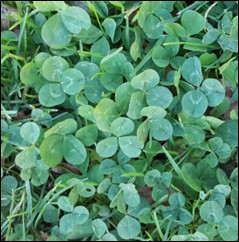
Dandelion (Taraxacum officinale)
- Perennial. Leaves, flower stalks, and taproot exude a milky sap when cut. Flowers are a pollen source for bees. Prefers fertile and cultivated soils.
- Leaves: arise from basal rosette. Oblong, usually hairless but sometimes sparsely hairy; deeply-lobed, with lobes pointing to center of rosette (base of plant); prominent midvein, margins wavy on older leaves. Leaves edible, with medicinal value.
- Stems: hollow, leafless stalk, 2-6 in. tall, with milky sap when broken. Unbranched flower stalk is only stem. Leaves in basal rosette are stemless.
- Flowers: solitary large yellow composite with ray and disk petals, 1.25-2 in. in diameter, produced on leafless stalks. Flowers May to June, with potential for a second bloom in autumn.
- Fruit: feathery pappus (tuft of hairs on each seed that assists dispersal by the wind) in mass; forms “puffball” - brown seed with light appendages.
- Roots: Deep, large taproot up to .5 in. in diameter.
- Reproduction: by wind-blown seeds and by new shoots that develop from broken segments of the taproot. Seeds germinate in top .75 in. of soil.
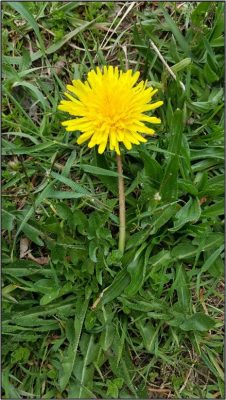
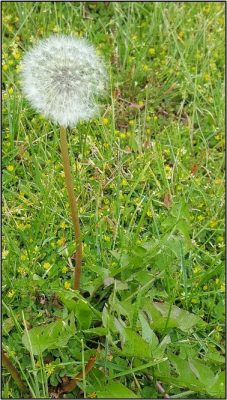
Prostrate Knotweed (Polygonum aviculare)
- Summer annual. Height usually 4-8 in. One of the first summer annual weeds to emerge in the spring, but can also emerge throughout the spring and summer. Prefers compacted, poorly draining soils.
- Leaves: .5-1.25 in. long and 1-8 mm wide; alternate, thinly oval, narrowed at the base and pointed at the tip. Petioles are very short, with a conspicuous ocrea sheathing the stem at the leaf base.
- Stems: prostrate to ascending; forms a tough, prostrate, wiry mat. Stems are slender, branched, longitudinally ridged, and swollen at the nodes.
- Flowers: white, small, inconspicuous; produced June to November in groups of 1-5. Axillary flower clusters are on flower stalks that are longer than the membranous, tubular sheaths.
- Roots: thin taproot.
- Reproduction: by seed.
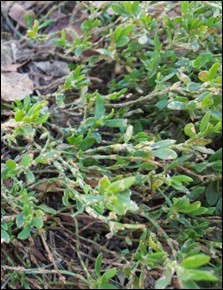
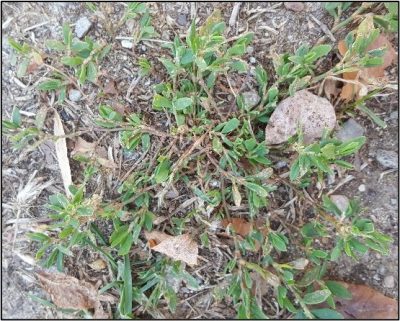
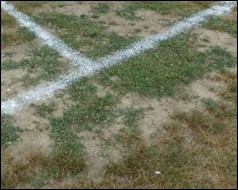
Broadleaf Plantain (Plantago major)
- Perennial. Thrives in compacted, low fertility soils.
- Leaves:5-7 in. long, up to 4 in. wide; broad, oval with conspicuous parallel veins, abruptly narrowing to a well-defined petiole. Smooth or slightly hairy; margins are entire, often wavy, rarely toothed. Leaf surface is often waxy and blue-green.
- Stems: form off a basal rosette. Petioles are sometimes reddish at the base. Leafless, unbranched, flowering stems appear for a short period in summer.
- Flowers: small, inconspicuous.
- Seeds: produced in a small, oval capsule that opens by a lid around the middle.
- Roots: short taproot with fibrous roots.
- Reproduction: by seed; germinates in late spring through midsummer and sporadically in early fall.
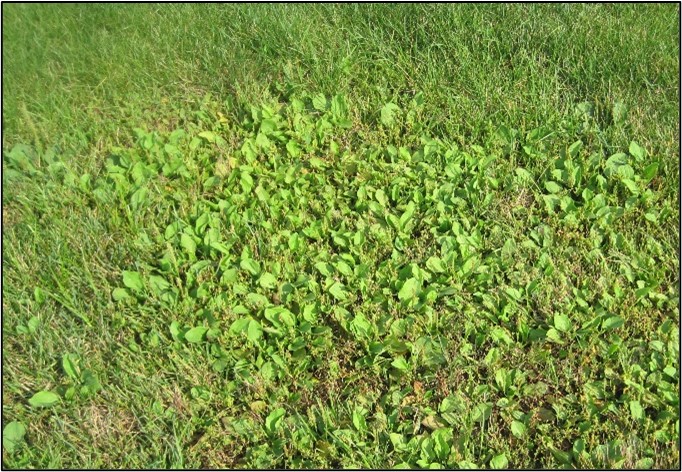
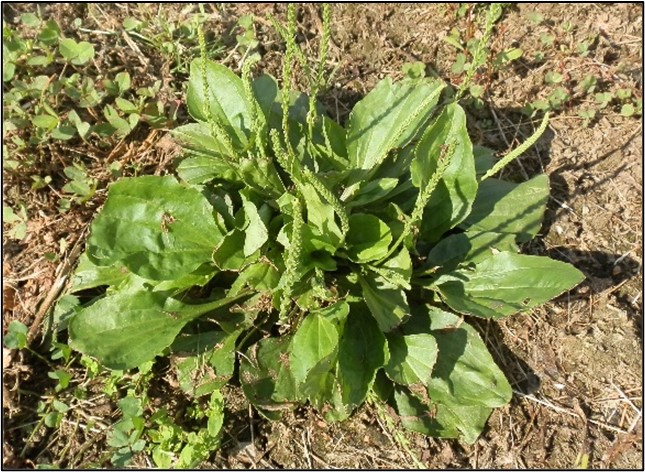
Narrow-leaved Plantain (Plantago lanceolata)
- Perennial. More common on drier sites and in neutral pH soils. Tolerates close mowing, but not frequent trampling.
- Leaves: about 5 times as long as wide (lanceolate), widest above the middle, often twisting or curled. 3-5 prominent parallel veins on the leaf blade. Leaf edges can be entire or slightly toothed. Leaf blades are usually smooth, but can have long silky hairs at the base. Leaves are somewhat erect, except in turfgrass, where they tend to be more prostrate. Overwintering leaves are wider than those produced in the summer.
- Stems: form a basal rosette. Well-established plants may produce a clump of several rosettes from the same crown.
- Flowers and seedheads: present June to September on the ends of leafless, unbranched, ridged stalks in dense cylindrical, cone-like spikes or heads. Individual flowers are inconspicuous.
- Roots: fibrous, produced from a thick, tough, short, taproot-like woody, undergound stem.
- Reproduction: by seed.
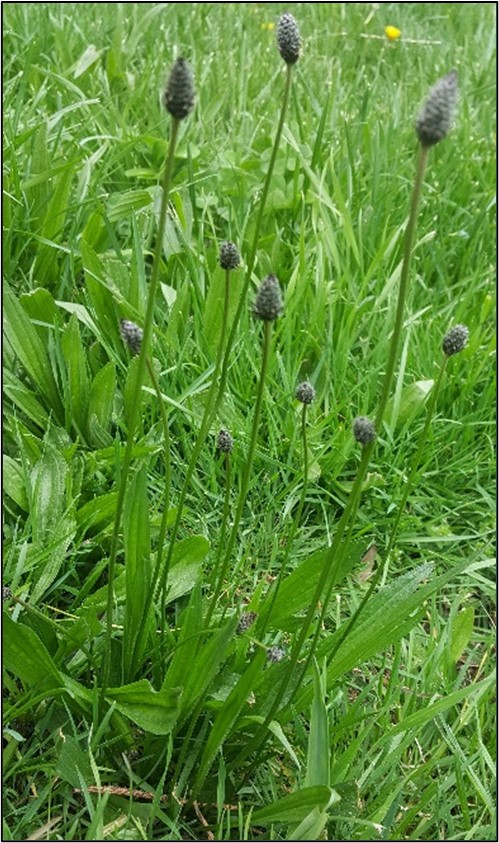
Spotted Spurge (Euphorbia maculata)
- Summer annual, spreading to 16 in. wide. Stems and foliage exude a milky sap when injured. Sap can be a skin irritant. Prefers infertile, compacted soils.
- Leaves: up to .5 in. long and less than half as wide, widest below the middle. Opposite, hairy, green, often with a maroon blotch on the upper leaf surface; on short petioles with stipules at the base.
- Stems: prostrate to ascending, mat-forming.
- Flowers: present from July to September in the axils of the upper leaves. Appear to be single, but are composed of several flowers in a cluster and are surrounded by a cup-like structure.
- Fruit: a 3-lobed capsule with stiff hairs on the surface.
- Roots: shallow taproot with secondary fibrous roots.
- Reproduction: by seed; germinates from early to late summer. Does not root at nodes. Seeds are produced when emerging plants are only a couple of weeks old.
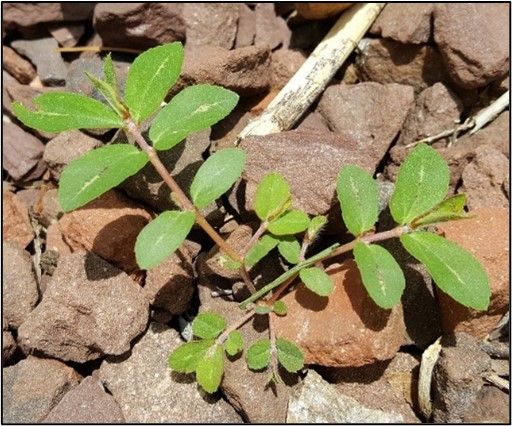

Violet (Viola papilionacea)
- Perennial. Prefers shady, moist fertile soils. Low-growing basal crown, 3-8 in. in height.
- Leaves: up to 3 in. long, heart-shaped, hairless, pointed at the tip, with rounded teeth on the margin. Petioles are about twice as long as the leaf blade.
- Stems: leafless, smooth, round.
- Flowers: present April to June, usually deep purple or blue, with 5 petals. Produced on leafless stalks that are usually no longer than the leaves.
- Fruit: capsule develops after petals drop; when mature, throws seed.
- Roots: stout, branching rhizomes and a coarse root system.
- Reproduction: by seed and rhizome. Forms colonies.
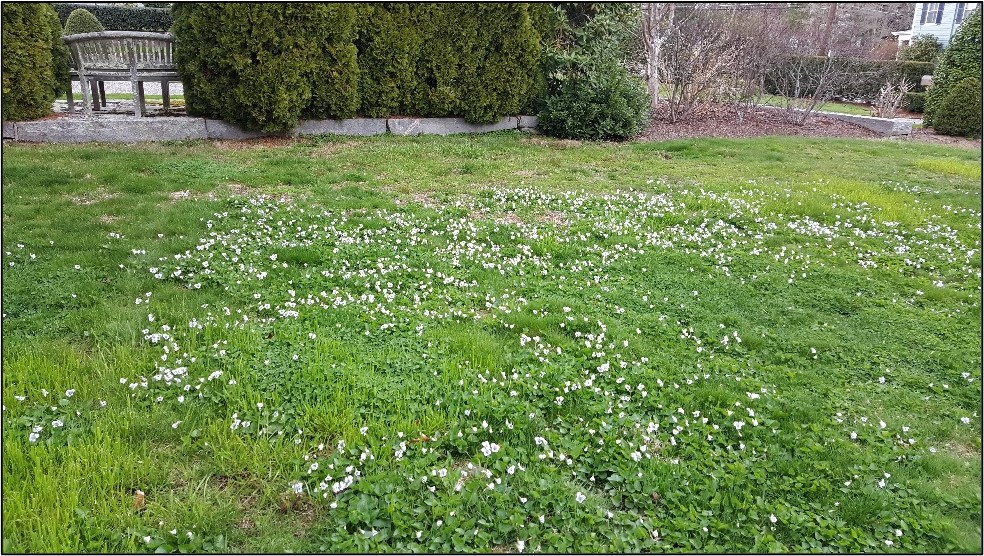
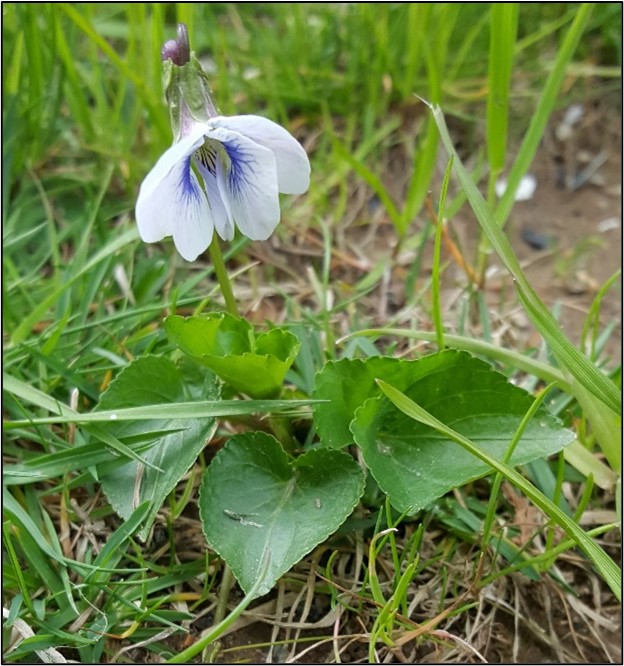
NOTABLE MENTIONS:
Red sorrel foliage

Red sorrel flowers

Hairy bittercress foliage

Hairy bittercress flowers
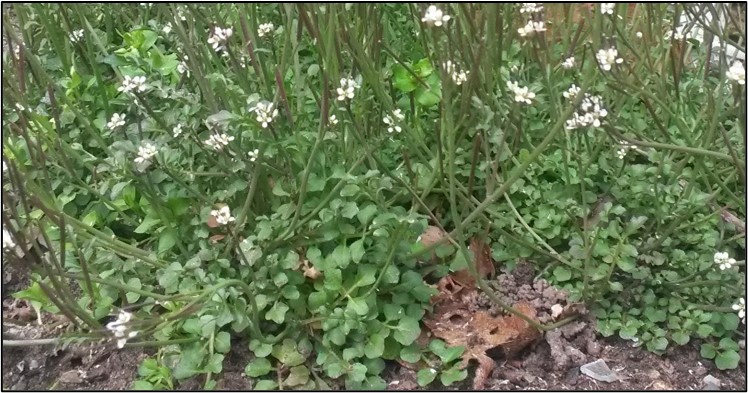
GLOSSARY OF TERMS USED IN THIS DOCUMENT:
Alternate: leaf pattern arrangement is one leaf per node.
Annual: a plant that completes its life cycle from seed to mature plant in one year. Winter annuals complete their life cycles from fall to spring. Summer annuals complete their life cycle from spring to fall.
Auricle: a small projecting lobe or appendage found where the leaf blade meets the leaf sheath.
Axil: the upper angle between one part of a plant and another; e.g. the stem and a leaf.
Collar: the area on the outer side of a grass leaf, at the junction of the blade and the sheath on the abaxial side of the leaf (away from the axis). The collar area is generally much lighter in color and varies in size and shape from species to species.
Entire: with a continuous, untoothed margin (leaf description).
Leaf blade: the leaf of grass or the broad portion of a leaf, as distinct from the petiole.
Leaf sheath: the basal part of a grass leaf, below the collar area, which encircles the stem.
Ligule: thin membranous appendage or ring of hairs on the inside of a leaf at the junction of the sheath and blade.
Node: the joint of a stem; the region of attachment of leaves to a stem.
Ocrea: papery sheath that encloses the stem at the nodes; made from the fusion of 2 stipules.
Opposite: leaf pattern arrangement is two leaves per node (where leaf comes from stem).
Perennial: a plant that lives more than two years. Continues growing until it reaches maturity (3-5 years on average).
Petiole: the stalk between the leaf blade and the stem.
Rhizome: an underground, elongated stem (or shoot) with scale leaves and adventitious roots arising from the nodes.
Sessile: stalkless and attached directly at the base (ex. sessile leaf).
Stipule: one of a pair of basal appendages of a leaf.
Stolon: an elongated stem (or shoot) that grows along the surface of the ground and from which leaves and adventitious roots develop at the nodes.
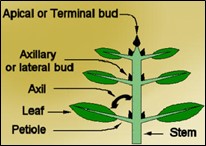


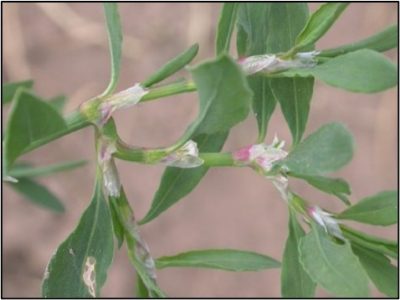
Sources:
- Connecticut Invasive Plant Working Group. (2018). Invasive Plant List. University of Connecticut Extension. cipwg.uconn.edu/invasive_plant_list/
- Patton, A. & Beck, L. (2015). Smooth Crabgrass. Purdue University. purdueturftips.blogspot.com
- Patton, A. & Law, Q. (2015). Quackgrass. Purdue University. purdueturftips.blogspot.com
- Reicher, Z., Patton, A., Bigelow, C., & Voigt, T. (Rev. 2006). ID and Control of Annual Bluegrass ID and Control of Annual Bluegrass and Rough Bluegrass in Lawns and Rough Bluegrass in Lawns. Purdue Extension & University of Illionois Extension. extension.purdue.edu/extmedia
- Michigan State University Extension. (n.d.). Turf Weeds: Annual Bluegrass. msuturfweeds.net/details/_/annual_bluegrass_47/
- Turgeon, A. J. (2011). Turfgrass Management. Reston, Virginia: Reston Publishing Co.
- Uva, R., Neal, J. & DiTomaso, J. (1997). Weeds of the Northeast. Ithaca: Cornell University Press.
Questions? Contact:
Vickie Wallace
UConn Extension
Extension Educator
Sustainable Turf and Landscape
Phone: (860) 885-2826
Email: victoria.wallace@uconn.edu
Web: ipm.uconn.edu/school
Funds to support the creation of this document were provided by the Connecticut Department of Energy and Environmental Protection. UConn Extension is committed to providing equal access and full participation for individuals with disabilities within all our programs and activities. Visit s.uconn.edu/accessibility for more resources. UConn is an equal opportunity program provider and employer.
©UConn Extension. All rights reserved.
Updated May 2017

